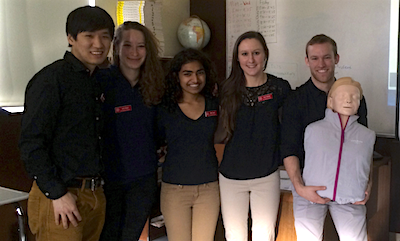When Medical Students Teach High-Schoolers CPR, Both Benefit.
 For years, the Bee Gees’ 1977 hit “Stayin’ Alive,” with its 100 beats per minute, has been part of teaching the correct tempo for CPR chest compressions, including for first-year medical students at Boston University. But when Anita Knopov and her fellow medical students turned around to teach high-schoolers, they had to find more up-to-date songs. Wiz Khalifa’s “Black and Yellow,” for example, has the right beat, says Knopov, who is also a pre-doctoral fellow at the School of Public Health.
For years, the Bee Gees’ 1977 hit “Stayin’ Alive,” with its 100 beats per minute, has been part of teaching the correct tempo for CPR chest compressions, including for first-year medical students at Boston University. But when Anita Knopov and her fellow medical students turned around to teach high-schoolers, they had to find more up-to-date songs. Wiz Khalifa’s “Black and Yellow,” for example, has the right beat, says Knopov, who is also a pre-doctoral fellow at the School of Public Health.
Whatever the 100-beats-per-minute track of choice, Knopov and her colleagues found that future doctors teaching high-schoolers CPR does work. Their study, published in the Journal of Education, shows that the hands-on program, called PumpStart, improved the knowledge, skills, and confidence of medical students and high school students alike.
“Students, from the beginning of time to med school, are always looking for ways to do something practical and skill-based instead of just reading a textbook,” Knopov says.
Knopov is one of the six medical students—the other five now graduates—who founded PumpStart, a program where first-year medical students from BU teach CPR at three nearby high schools: two City on a Hill schools in Roxbury, and Fenway High School. Any interested first-year medical student and any interested high-schooler can take part.
The class includes watching an edited-down version of the American Heart Association’s CPR Anywhere video (“We cut out a lot of the boring and dry parts and made it about the nuts and bolts,” Knopov says, “because we’re students too, and we know what flies and what doesn’t fly.”), then practice with a CPR mannequin and the requisite 100-beats-per-minute jam.
“The first semester, because medical school and high school schedules don’t always line up, we had it as an option to get out of detention,” Knopov says, although plenty of other high-schoolers were also interested. “It was definitely well-received—especially compared to detention.”
The high-schoolers really got into it, she says. They were engaged and energized by the opportunity to do something hands-on, and to “compete” to see who could do CPR the best. “It isn’t semantics and formulas. It feels much more real, because there is this actual skill, this real thing that could eventually come in use.”

Most importantly, Knopov and her colleagues found that the high school students were actually learning. She and the other student-teachers had the participants fill out anonymous surveys before and after the training, showing major improvements in how much they knew—and how they felt about their ability to administer bystander CPR.
An estimated 395,000 cases of cardiac arrest occur outside of a hospital in the US every year, and all but 6 percent are fatal. “Any CPR is better than no CPR,” Knopov says. “This isn’t certified CPR, it’s just bystander CPR, so, really, you’re just trying to increase circulation. There aren’t a lot of ways to do it blatantly wrong. The hardest thing is being empowered to do it.” Not being able to remember the right song to use for tempo, or what the acronym even stands for, shouldn’t stop someone from trying to save a life, she says.
The high school students weren’t the only ones who filled out pre- and post-surveys. The medical students also reported feeling significantly more confident and comfortable teaching and answering questions about CPR. “A lot of day-to-day medicine is educating your patients,” Knopov says. “You can tell them to do whatever you think is right, but you’re not going to achieve anything if they don’t understand you and if you don’t have a relationship.”
Relationship-building is another key, if less tangible, purpose of PumpStart, Knopov says. “Most of the high school students—qualitatively, from talking to us—had no exposure to the medical field except for going to the doctor.” That was why, beyond the training sessions, the PumpStart program has also tried to increase that exposure, including throwing a party at one of the schools with high-schoolers, medical students, EMTs, and the program’s faculty advisor, Ricky Kue, an assistant professor of emergency medicine at the School of Medicine and the associate medical director of Boston EMS, Police & Fire. That and other interactions, Knopov says, send these high-schoolers the message that “there are role models less than a mile away.”
Bringing medical students into the communities they serve is also vital, she says. “The biggest thing for us as students in the medical field is to see patients in their own environment,” Knopov says. “We see people in the hospital, and then we discharge them back to where they came from. But if we’re one mile away from where they came from, and we’re not engaging with that community, then we’re not really doing our part.”
Comments & Discussion
Boston University moderates comments to facilitate an informed, substantive, civil conversation. Abusive, profane, self-promotional, misleading, incoherent or off-topic comments will be rejected. Moderators are staffed during regular business hours (EST) and can only accept comments written in English. Statistics or facts must include a citation or a link to the citation.